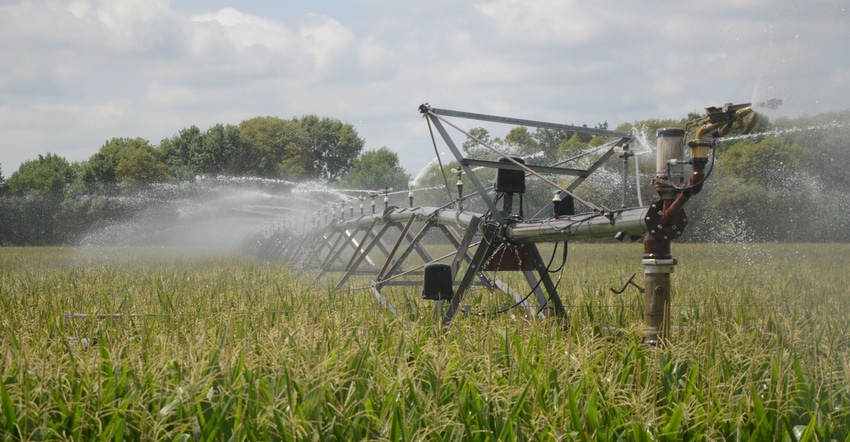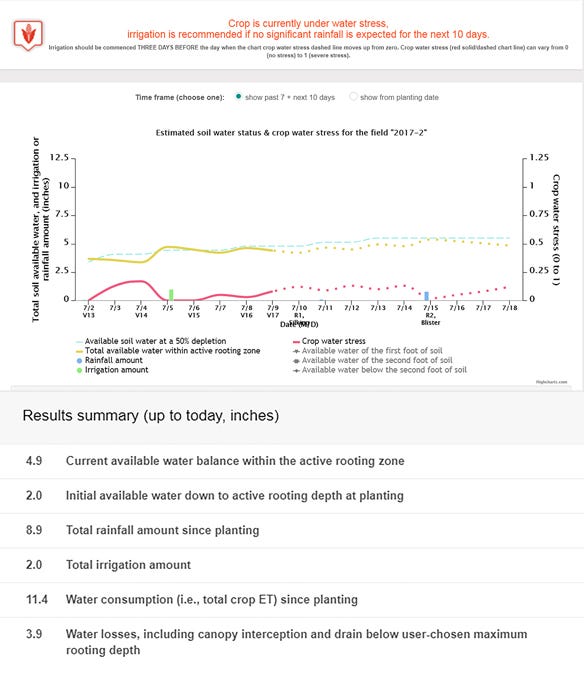May 29, 2020

Another irrigation season for corn and soybeans has arrived. Irrigators will be facing another round of challenges on their irrigation decision-making with two questions constantly in their mind: How much crop-available water is currently in the soil, and when do I need to turn on irrigation?
CornSoyWater, the University of Nebraska-Lincoln's online irrigation decision support, is designed to aid irrigation scheduling for corn and soybean fields, and the program is free to use.
How CornSoyWater works
Using the online weather data from the weather station that is closest to the user-specified field, CornSoyWater simulates up-to-date crop growth and development, crop water use, and the amount of water in the active rooting zone (see Figure 1).
The program will recommend irrigation for the field if crop water stress is probably occurring or will occur within next three days, as in the example in Figure 1.

Figure 1. CornSoyWater predictions of crop stages, available water in soil, irrigation threshold, rainfall events, and irrigation record (upper graph), and summary table for a cornfield in 2017.

Besides the graphic display, the program also provides a summary table on the soil water balance of the field, including from planting-to-now total rainfall, crop water use, and water balance, as shown in the lower part of Figure 1.
Behind the screen, the CornSoyWater program uses the SoySim and Hybrid-Maize models to accomplish the following tasks for a field based on user-specified information:
simulating the up-to-date crop stage and growth
tracking crop water use and water inputs from rainfall and past irrigations, and calculating the amount of crop-available water in the active rooting depth
recommending irrigation if the water in the soil is likely to fall below the threshold for irrigation in the next three days.
Field-specific info required from users
When adding a field, the user will need to provide basic information, including:
location of the field (by marking it directly on the Google map)
crop maturity (relative maturity in days for corn, or maturity group for soybeans)
date of planting
soil moisture status at planting
Account registration is free and easy
New users must register for a free account. Visit cornsoywater.unl.edu, which will take you to the program’s home page. Then click on "beginner clicks here" on the upper right of the page, which will take you to the next steps. Follow the instructions on the screen to create your account and sign up your fields.
Two YouTube vides are available on the website to explain how the program works and how to use it.
Word of caution
As with many scientific models, the CornSoyWater program might produce results that deviate from reality, especially under unusual conditions. As a result, irrigators should exercise caution when using the program and combine results from CornSoyWater with their current irrigation guidelines.
Funding for the development of the CornSoyWater program was provided by the Nebraska Soybean Board and Nebraska Corn Board; Water, Energy and Agriculture Initiative (WEAI); and UNL Water For Food Institute.
Yang is a crop modeler in the Department of Agronomy and Horticulture at the University of Nebraska-Lincoln. He can be reached at [email protected].
You May Also Like




